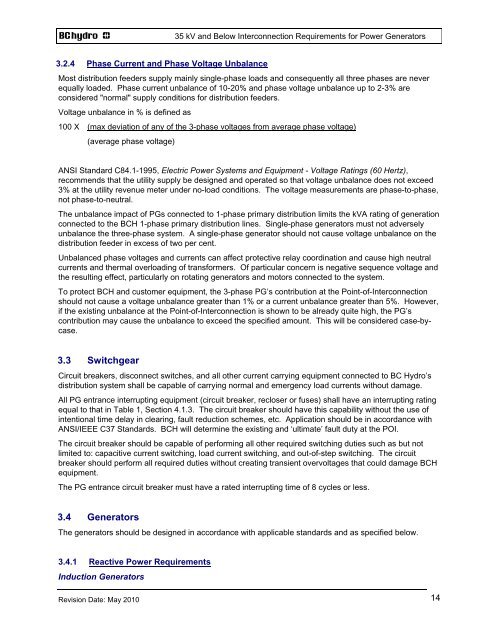35 kV and Below INTERCONNECTION REQUIREMENTS - BC Hydro
35 kV and Below INTERCONNECTION REQUIREMENTS - BC Hydro
35 kV and Below INTERCONNECTION REQUIREMENTS - BC Hydro
Create successful ePaper yourself
Turn your PDF publications into a flip-book with our unique Google optimized e-Paper software.
3.2.4 Phase Current <strong>and</strong> Phase Voltage Unbalance<br />
Revision Date: May 2010<br />
<strong>35</strong> <strong>kV</strong> <strong>and</strong> <strong>Below</strong> Interconnection Requirements for Power Generators<br />
Most distribution feeders supply mainly single-phase loads <strong>and</strong> consequently all three phases are never<br />
equally loaded. Phase current unbalance of 10-20% <strong>and</strong> phase voltage unbalance up to 2-3% are<br />
considered "normal" supply conditions for distribution feeders.<br />
Voltage unbalance in % is defined as<br />
100 X (max deviation of any of the 3-phase voltages from average phase voltage)<br />
(average phase voltage)<br />
ANSI St<strong>and</strong>ard C84.1-1995, Electric Power Systems <strong>and</strong> Equipment - Voltage Ratings (60 Hertz),<br />
recommends that the utility supply be designed <strong>and</strong> operated so that voltage unbalance does not exceed<br />
3% at the utility revenue meter under no-load conditions. The voltage measurements are phase-to-phase,<br />
not phase-to-neutral.<br />
The unbalance impact of PGs connected to 1-phase primary distribution limits the <strong>kV</strong>A rating of generation<br />
connected to the <strong>BC</strong>H 1-phase primary distribution lines. Single-phase generators must not adversely<br />
unbalance the three-phase system. A single-phase generator should not cause voltage unbalance on the<br />
distribution feeder in excess of two per cent.<br />
Unbalanced phase voltages <strong>and</strong> currents can affect protective relay coordination <strong>and</strong> cause high neutral<br />
currents <strong>and</strong> thermal overloading of transformers. Of particular concern is negative sequence voltage <strong>and</strong><br />
the resulting effect, particularly on rotating generators <strong>and</strong> motors connected to the system.<br />
To protect <strong>BC</strong>H <strong>and</strong> customer equipment, the 3-phase PG’s contribution at the Point-of-Interconnection<br />
should not cause a voltage unbalance greater than 1% or a current unbalance greater than 5%. However,<br />
if the existing unbalance at the Point-of-Interconnection is shown to be already quite high, the PG’s<br />
contribution may cause the unbalance to exceed the specified amount. This will be considered case-bycase.<br />
3.3 Switchgear<br />
Circuit breakers, disconnect switches, <strong>and</strong> all other current carrying equipment connected to <strong>BC</strong> <strong>Hydro</strong>’s<br />
distribution system shall be capable of carrying normal <strong>and</strong> emergency load currents without damage.<br />
All PG entrance interrupting equipment (circuit breaker, recloser or fuses) shall have an interrupting rating<br />
equal to that in Table 1, Section 4.1.3. The circuit breaker should have this capability without the use of<br />
intentional time delay in clearing, fault reduction schemes, etc. Application should be in accordance with<br />
ANSI/IEEE C37 St<strong>and</strong>ards. <strong>BC</strong>H will determine the existing <strong>and</strong> ‘ultimate’ fault duty at the POI.<br />
The circuit breaker should be capable of performing all other required switching duties such as but not<br />
limited to: capacitive current switching, load current switching, <strong>and</strong> out-of-step switching. The circuit<br />
breaker should perform all required duties without creating transient overvoltages that could damage <strong>BC</strong>H<br />
equipment.<br />
The PG entrance circuit breaker must have a rated interrupting time of 8 cycles or less.<br />
3.4 Generators<br />
The generators should be designed in accordance with applicable st<strong>and</strong>ards <strong>and</strong> as specified below.<br />
3.4.1 Reactive Power Requirements<br />
Induction Generators<br />
14
















